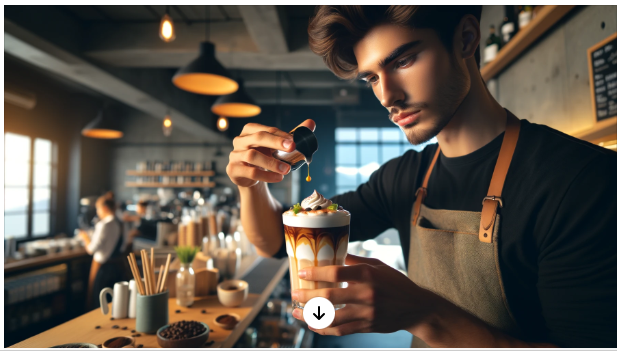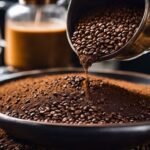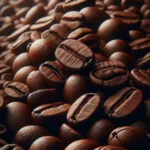You’ve likely sipped a cup of joe and wondered how it got its unique twist of taste. Flavored coffee beans have been tickling palates with tastes like hazelnut, vanilla, and caramel since their boom in the ’90s.
This post will unwrap the secrets behind these aromatic wonders, guiding you to choose or even create your own perfect brew. Dive in—and let’s flavor up!
Key Takeaways
- Flavored coffee beans are regular coffee beans coated with syrups or oils after roasting to add tastes like vanilla, chocolate, or spices.
- You can choose from natural and artificial flavors for your coffee, but some people worry about chemicals in artificial flavors.
- Check the quality and freshness of flavored coffee beans by looking at where they come from, how they’re roasted, and their production dates.
Understanding Flavored Coffee
Dive into the world of flavored coffee, a realm where your everyday cup transcends to unexpected sensations. Here, you’ll explore how vanilla hazelnut or pumpkin spice become not just whimsical names but aromatic journeys that redefine your morning ritual.
Flavored coffee has its origins in the 1800s when coffee drinkers first started experimenting with adding nuts, spices, chocolate and other flavorings to enhance their daily cup. The trend continued through the 1900s with European coffeehouses using syrups, herbs and more to create signature flavor combinations.
The gourmet coffee boom of the 1990s and the mass market popularity of flavored coffee in recent decades has led to the immense range of flavored options we see today.

Definition and difference from regular coffee
Flavored coffee beans are regular coffee beans that have extra tastes added to them. These tastes can make your morning cup feel like a special treat. You might taste things like vanilla, chocolate, caramel, or spices in these coffees.
The plain coffee you’re used to doesn’t have these added flavors.
The process for making flavored coffee is pretty cool. First, roasters take freshly roasted beans and then they add flavorings while the beans are still warm because that’s when they soak up flavors best.
This is different from how you make normal coffee which keeps the natural taste of the bean without adding anything extra.
Some people love trying different flavors in their coffee like pumpkin spice or French vanilla. Others prefer sticking with traditional types because they enjoy tasting the unique notes each kind of bean naturally has.
Flavored coffees offer fun choices for those who want to mix it up!
But is flavored coffee safe and healthy?
Popular flavors and trends
Coffee drinkers have a wide array of choices when it comes to adding zing to their brew. Imagine sipping your morning coffee and getting a hint of creamy caramel or the rich taste of chocolate — flavors like these are what make many reach for flavored beans.
Vanilla, hazelnut, and amaretto remain classics, but trends always bring new tastes. Blueberry muffin or Irish cream might catch your eye on the shelf, offering an extra layer of joy in your cup.
Specialty shops often lead the way with unique offerings — fudge brownie or butter pecan could be next on their list. Seasonal favorites also play a big role; think pumpkin spice in the fall or peppermint around the holidays.
Innovations don’t stop there: some roasters now use whiskey and rum barrels for that subtle kick without the alcohol content, attracting those who love a good twist in their java.
The world of gourmet coffee keeps expanding as people look for more ways to delight their senses each day. With delicious options like cherries jubilee or cinnamon spice popping up, you’re bound never to get bored.
There’s always something new brewing around the corner that can transform an ordinary coffee experience into something extraordinary.
Extra flavors to consider
With new flavor combinations emerging constantly, there is a vast world to explore beyond common offerings like french vanilla or hazelnut. Consider trying more unique or up-and-coming options like:
- Fruit-infused coffees: Recent trends include flavors like blueberry, strawberry, and coconut lending fruity notes. Beans soaked in fruit essences or with fruit powders mixed in can provide a sweet, vibrant taste.
- Boozy infusions: Alcohol-inspired flavors are also gaining traction. Whiskey, rum, Kahlua, and brandy-infused beans can give coffees depth while avoiding harsh alcohol flavor.
- Nutty mixes: Almonds, pecans, pistachios — blending the richness of nuts into coffee balances sweetness. Roasted nut flavors pair especially nicely with darker roasts.
- Drink mashups: Flavored beans fusing the taste of popular drinks are also emerging like chai tea coffee, matcha coffee, and tiramisu or Irish cream coffee.
- Savory spices: Chili-spiked coffees offer some heat, while mixes with garlic, turmeric, oregano and basil create almost broth-like multifaceted flavors.
The possibilities are infinite! Try rotating through unique options to liven up your daily routine while supporting small batch specialty roasters experimenting with flavor innovation.
The Making of Flavored Coffee Beans

Dive into the artistry behind your favorite morning boost—flavored coffee beans are a spectacle of taste, crafted through an infusion process that marries rich coffee with enticing flavors.
Discover how meticulously chosen flavorings transform ordinary beans into an extraordinary experience for your palate.
Infusion process
To make flavored coffee beans, they soak up syrup or aroma. This happens because the beans are like sponges. They pull in all the smell and taste from flavors until you grind them.
Some flavors come from barrels used for whiskey and rum.
They do this after roasting so that you get a strong flavor in your cup of coffee. You can find many kinds—vanilla, chocolate, caramel—and each one changes how your coffee tastes.
Moving on to what they use to make these yummy flavors..
Types of flavorings used
Flavoring coffee beans is an art. Roasters use a mix of natural and artificial flavors to make each batch special. Natural flavors come from real food items like vanilla beans, cocoa, or spices.
These give your coffee that taste of the real thing, just like mother nature made it.
Artificial flavors are also popular in making flavored coffee. They’re created by scientists who know how to mix different flavor compounds together. This can lead to exciting tastes like blueberry muffin or maple bacon that you might not find in nature.
When roasters add these flavors to the beans, they wait until the roasted coffee has cooled down a bit. That way, when they pour on liquid flavorings such as oils or syrups, the porous beans soak them all up.
Before moving onto advantages and disadvantages of flavored coffees.. let’s chat about how these flavors impact more than just taste buds—they can turn your morning cup into something truly special!
DIY Alternatives: Creating Healthier Homemade Flavors
Adding your own flavors opens a world of options for affordable gourmet-tasting combinations!
Try out these delicious homemade flavored coffee recipes:
| Recipe | Ingredients | Instructions |
|---|---|---|
| Pumpkin Spice Latte | 1 tsp pumpkin pie spice, 1 tbsp pureed pumpkin, 1 tsp brown sugar | Combine ingredients into freshly brewed coffee. Finish with foamed milk. |
| Vanilla Cinnamon Iced Coffee | 1⁄2 tsp vanilla, 1⁄4 tsp cinnamon | Mix ingredients into strong chilled coffee. Add ice and a splash of milk. |
| Caramel Macchiato | 1⁄2 tbsp caramel sauce, Pinch of sea salt | Stir ingredients into hot espresso shots. Top with foamed milk and creamy foam. |
| Orange Mocha | 2 tbsp cocoa powder, 1⁄2 tsp orange zest, 1 tbsp orange juice | Whisk cocoa powder and orange zest into hot coffee. Mix in orange juice. Top with whipped cream. |
Advantages and Disadvantages of Flavored Coffee
Diving into the world of flavored coffee opens up a sensory playground, yet it’s not without its own set of swings and roundabouts. You’ll uncover how added flavors can transform your morning brew—bringing joy or perhaps an unexpected twist—to both your palate and well-being.
Pros and cons of added flavors
Pros
Flavored coffee beans give your cup an extra kick. They can add fun and variety to your morning routine. Here’s what you should know about the good and bad of added flavors:
- Variety is key! With so many flavors to choose from, you never get bored.
- Do you love sweets? Flavored coffees can taste like your favorite treats without the sugar.
- Feeling fancy? Some flavors make your regular cup feel like a pricey cafe drink.
- They’re quick and easy. You get flavor without needing syrups or whipped cream.
Cons
- Flavoring compounds often include chemicals like propylene glycol, which some folks avoid.
- Purists argue that such flavors mask the true taste of quality beans.
- Coffee equipment might suffer – oils from flavorings can cause buildup and damage over time.
- Sometimes these beans hide lower-quality coffee. The strong flavors cover up any not-so-great taste.
Impact on health and nutrition
Adding flavors to your coffee might make it taste better, but sometimes these come with health concerns. Some flavored coffee beans use chemical flavoring agents. These chemicals may not be good for you if you drink a lot of coffee or care about eating natural foods.
Also, the strong scents from flavored coffees can stick to your skin and clothes for a long time. This could affect how clean you feel and even impact your health.
Watch out for any signs of allergies or bad reactions when trying new flavored coffees, especially if they have ingredients that are common allergens. Next up, let’s explore how the demand for these tasty brews is changing the world of coffee shops!
Meeting the Demand for Flavored Coffee
In the caffeinated hustle of modern life, specialty coffee shops are brewing up a storm to satisfy your yearning for that vanilla twist or chocolatey finish. This surge in variety is reshaping the traditional coffee market as we speak—making every sip an adventure in flavor.
Rise of specialty coffee shops
Specialty coffee shops started popping up more and more in the ’90s. This was big for flavored coffee because these shops offered lots of new tastes. Think vanilla, caramel, chocolate – you name it, they had it.
These spots made enjoying a cup of coffee an experience folks looked forward to.
People love trying out fancy flavors at these places. They also like seeing how baristas make their drinks with style and care. Watching your latte or cappuccino being made just right can feel special.
It’s not just about getting a caffeine kick anymore; it’s about savoring all those delicious flavors in your cup.
Everywhere you look now, there are specialty coffee joints offering unique blends and brews. They’ve changed how we think about our daily java routine, pushing regular old ground coffee to find its place alongside exciting new options! Coffee enthusiasts often gather here to enjoy high-quality Arabica beans turned into something extraordinary with a dash of flavoring oils or syrups that keeps them coming back for more.
Impact on traditional coffee market
Flavored coffee beans are changing the game for classic coffee markets. They bring a new twist to your usual cup, making plain brews seem less exciting. You see more people trying out flavors like vanilla, chocolate, and caramel at their favorite spots.
This shift means traditional coffee shops have to think fast to keep up with these tasty trends.
Coffee drinkers now expect a variety of choices wherever they go. Old-school cafes may add flavored syrups or start brewing flavored beans just to stay in the race. And as these bold flavors win hearts, regular bean sales might feel the pinch.
But let’s not forget; quality always counts, no matter how you spice up your drink.. Now let’s talk about what goes into these flavor-packed beans you love so much.
Common Ingredients in Flavored Coffee
In the realm of flavored coffee, the ingredients list can be quite diverse—ranging from natural oils extracted from spices and nuts to lab-created compounds designed expressly for that creamy taste or chocolatey undertone.
For those with sensitivities, it’s crucial to note that some blends might contain common allergens or additives recognized as safe but still worth scrutinizing.
Natural and artificial flavorings
Flavored coffee beans get their taste from natural and artificial flavorings. Companies mix these flavors with a liquid like propylene glycol. They then pour this over the roasted beans.
The beans soak up the mixture, which gives you that special taste when brewed.
Natural flavorings come from real things like vanilla pods or cocoa beans. For example, vanilla flavored coffee might use extract made from real vanilla. Artificial flavors are made in labs to copy those tastes.
Both types let you enjoy many different flavors in your cup of coffee.
You should know some people worry about artificial flavors. They prefer natural ones because they avoid chemicals in their diet. Yet, all flavorings used must be recognized as safe to use in food and drinks.
So whether it’s a creamy caramel flavored coffee or rich chocolate notes you’re after, there’s likely an option out there for you!
Potential allergens and sensitivities
Some of you might love your coffee with a kick of flavor—like chocolate or crème brulee. But, it’s important to know that flavored coffee beans often have extra ingredients. These could be natural or made by people in labs.
If you’re someone who has allergies or food sensitivities, these added bits can cause problems for you.
The process that puts flavor into the beans makes them soak up both smell and taste. Be careful if you have allergies because flavored beans might trigger a reaction. It’s just like how some folks can’t eat nuts or dairy without getting sick; the same thing can happen with certain flavors in your brew.
If this worries you, one safe way is to add flavors to your brewed coffee yourself, rather than choosing pre-flavored beans. This lets you control what goes into your cup and keeps those sneaky allergens away.
Plus, making sure to check labels and being aware of what’s inside your flavored coffee will help keep any bad reactions at bay while still letting you enjoy a variety-filled coffee experience!
How Commercial Roasters Make Flavored Coffee Beans
You might wonder how your favorite chocolate-flavored coffee gets its irresistible taste. Commercial roasters have their secrets – a symphony of techniques and precision, ensuring every bean is coated with the perfect amount of flavor to delight your senses on that first morning sip.
Different techniques and methods
Making flavored coffee beans is a creative process. Roasters combine the rich taste of coffee with exciting flavors.
- The infusion method involves adding flavor to coffee beans after they are roasted. High – quality coffee gets coated with flavored oils or syrups, ensuring each bean has absorbed the taste.
- Barrel finishing is a special technique some use for a twist in flavor. Coffee beans rest in whiskey or rum barrels, picking up subtle alcoholic notes.
- Some coffee drinks come from mixing whole spices directly with the grounds. This way, cinnamon or nutmeg adds a natural kick to your brew.
- Commercial roasters often spray warm beans with liquid flavoring. This gives chocolate – flavored coffee or other varieties their distinct taste.
- A slow tumbling process helps the flavor stick better to the roasted beans. It ensures the desired flavor blends thoroughly before packaging.
- For health – conscious drinkers, natural extracts serve as a safer option over artificial chemicals which may carry risks.
- Air tight sealing captures and locks in freshness and aroma right after roasting and flavoring, guaranteeing a punch of taste in every cup.
Quality control and standards
In the world of flavored coffee, quality is key. You want your beans to taste just as good as they smell. To make sure this happens, companies set high standards for their products.
They check everything from the flavorings they use to how well the beans have absorbed those flavors.
These checks happen in labs with strict rules. Workers follow detailed steps so every batch of coffee has the same great taste. This way, when you brew a cup at home, it’s perfect every time.
Now that you know how flavored coffee beans are made, it’s important to store them properly to retain maximum freshness and flavor. To learn tips for storing flavored coffee beans to lock in aroma and taste, check out this guide on how to store coffee beans for maximum freshness.
After talking about how important it is to keep an eye on quality and standards, let’s move on to why some coffee makers don’t like flavored coffee beans.
Why Some Coffee Makers Don’t Like Flavored Coffee Beans
While you might relish the twist of vanilla or the hint of hazelnut in your morning cup, some coffee makers turn their noses up at flavored beans. They argue that artificial additives mask the bean’s natural qualities—a point of contention for purists who believe coffee should speak for itself.
Possible equipment and flavoring oil conflicts
You love your coffee sweet and flavorful. But, flavored coffee beans can be sticky! They sometimes leave behind a residue. This gunk can get on grinders and other equipment. It can make things messy and hard to clean.
Coffee makers are careful with their machines. They don’t want the syrupy stuff from flavoring oils to mess up their gear. Some avoid using flavored beans because of this. It helps keep their tools in good shape for making lots of great coffee.
Alternative brewing methods for flavored coffee
Flavored coffee doesn’t just come from flavored beans. You can also create your own taste adventures right in your cup. Add a dash of cinnamon or a splash of maple syrup to freshly brewed coffee for an instant flavor boost.
Some folks like to stir in chocolate syrup or a pinch of vanilla extract – it’s all about what tickles your taste buds.
Another fun way is using different creams and milks. These can add new layers to your drink without needing special beans. Think outside the box – mix spices, sugars, or even bits of candy into your brew.
This way, you make each mugful as unique as you are!
Things to Consider Before Purchasing Flavored Coffee Beans
When you’re on the hunt for the perfect bag of flavored coffee beans, don’t just grab any sparkly package off the shelf. Pause and consider what really contributes to that rich, aromatic experience—think bean quality, roast profiles, and how fresh those flavors are dancing in your cup.
Quality of beans
Good coffee starts with good beans. You want quality coffee beans if you’re going to choose flavored coffee. The best ones come from places known for growing great coffee. Think of areas like Brazil, Colombia, or Ethiopia.
These countries have the right weather and soil to grow tasty coffee.
The roast level matters too. Lighter roasts let the bean’s natural taste shine through—this works well with subtle flavors. Darker roasts give a stronger, bolder taste that can hold up against intense flavors like chocolate or nutmeg.
Before buying flavored coffee, check where the beans are from and how they were roasted. This info often tells you a lot about the taste you’ll get in your cup! Be sure also to look at product dates so your flavor stays fresh and delicious until the last sip.
Origin and roast level
You’ve picked out some great beans for your flavored coffee, but now let’s talk about where they come from and how they’re roasted. The origin of the bean can change how your coffee tastes before any flavors even touch it.
Beans grow in different parts of the world—like Africa, Asia, and South America—and each place gives them a unique taste.
The roast level adds another layer to this taste adventure. Light roasts keep more of the original bean flavor while dark roasts have a stronger, bolder taste. When companies make flavored coffee, they usually start with medium or medium-dark roasts because these have balanced flavors that mix well with added tastes like chocolate or vanilla.
Every step—from picking the right beans to finding just the perfect roast—is all about creating that delicious sip you love!
Production and expiration date
Check the label for production and expiration dates before you buy flavored coffee beans. These dates will help you enjoy your coffee when it tastes best. Freshness matters—a fresh bean holds onto its flavor better than an old one.
Now, think about what others say who have tried these flavors. Customer reviews and ratings can guide you to find great tasting flavored coffee that others love too.
Conclusion
So, flavored coffee beans are a fun twist on your regular cup. They soak up tasty syrups to give them their special taste. Remember, you’ve got lots of flavors like blueberry and caramel to try! Just pick what you love and check the quality before buying.
Now go ahead, find your favorite flavor, and enjoy every sip!
FAQs
1. What are flavored coffee beans?
Flavored coffee beans… they’re just regular coffee beans, right? But here’s the twist – they get a boost from extra tastes! Companies add different flavors to make sipping your cup more exciting.
2. Can you choose from many flavors or just a few?
You bet! There’s a whole variety of flavors out there for flavored coffee drinkers. From vanilla to hazelnut, and even fruity ones, it’s like a flavor party for your taste buds!
3. How do they put the flavor into the coffee beans?
Ah, the roasting process—that’s where the magic happens. Beans get roasted to perfection first. Then—splash!—they mix in special oils with yummy flavors while the beans are still warm.
4. Is decaf available in flavored coffees too?
Sure thing – decaf doesn’t miss out on any fun! Both caffeinated and decaf versions can dance together in flavor heaven.
5. Do small or big companies make these fancy-flavored coffees?
Both play the game! Smaller roasters pour their hearts into crafty concoctions, while bigger players offer those reliable favorites everybody knows and loves.






